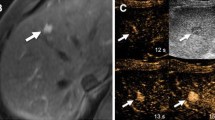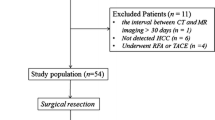Abstract
Purpose
The aim of this study was to assess the role of contrast-enhanced ultrasonography (CEUS) in the characterisation of focal liver lesions in comparison with multidetector computed tomography (MDCT) and magnetic resonance imaging (MRI) with liver-specific contrast agent.
Materials and methods
One hundred and eighty-seven focal liver lesions, 91 malignant and 96 benign (mean size 3.2 cm) — proved by biopsy (n=12), histology (n=4), MDCT (n=108), MRI (n=44) MDCT/MRI (n=19) — in 159 patients were studied by CEUS. Two expert radiologists consensually evaluated the contrast-enhancement patterns at CEUS. For each lesion, they assessed: (a) nature (benign, malignant, not assessable), (b) specific diagnosis and (c) need for further radiological evaluation. Sensitivity, specificity, positive and negative predictive values and diagnostic accuracy of CEUS were calculated.
Results
A total of 167/187 (89.3%) lesions were correctly assessed as benign or malignant at CEUS, whereas 14/187 (7.5%) lesions remained undetermined and 6/187 (3.2%) were incorrectly assessed. Sensitivity, specificity, positive and negative predictive values and diagnostic accuracy of CEUS were, respectively, 89%, 89.6%, 89%, 89.6% and 89.3%. The need for further radiological evaluation decreased to 46/187 (24.6%) lesions after CEUS (p<0.001).
Conclusions
In selected cases, CEUS can be considered an effective alternative to MDCT and MRI and reduce the need for further radiological workup.
Riassunto
Obiettivo
Scopo del nostro studio è stato valutare il ruolo dell’ecocontrastografia nella caratterizzazione delle lesioni focali epatiche confrontandola con apparecchiature di tomografia computerizzata multidetettore (TCMD) e risonanza magnetica (RM) con mezzo di contrasto (MdC) epatospecifico.
Materiali e metodi
Centottantasette lesioni focali epatiche, 91 maligne e 96 benigne (diametro medio: 3,2 cm), in 159 pazienti, confermate mediante biopsia (n=12), istologia (n=4) TCMD, (n=108), RM (n=44) TCMD e RM (n=19), sono state studiate con ecocontrastografia, TCMD e/o RM. Due radiologi hanno valutato in consenso gli aspetti ecocontrastografici, indicando per ciascuna lesione: a) diagnosi di natura (benigna, indeterminata, maligna); b) diagnosi specifica; c) necessità di ulteriori indagini radiologiche. Sono stati calcolati sensibilità, specificità, valori predittivo positivo e negativo, nonché l’accuratezza diagnostica dell’ecocontrastografia.
Risultati
L’ecocontrastografia ha consentito una corretta diagnosi (benigne vs maligne) in 167/187 (89,3%) casi. Quattordici/187 (7,5%) lesioni sono rimaste indeterminate e 6/187 (3,2%) non sono state correttamente caratterizzate dopo ecocontrastografia, con valori di sensibilità, specificità, valore predittivo positivo, negativo e accuratezza diagnostica pari, rispettivamente, all’89%, all’89,6%, all’89%, all’89,6% e all’89,3%. Dopo ecocontrastografia, la necessità di ricorrere a ulteriori indagini radiologiche si è ridotta a 46/187 casi (24,6%) (p<0,001).
Conclusioni
L’ecocontrastografia può essere considerata, in casi selezionati, una valida alternativa alla TCMD ed alla RM, riducendo il ricorso ad ulteriori indagini radiologiche.
Similar content being viewed by others
References/Bibliografia
Harvey CJ, Albrecht T (2001) Ultrasound of focal liver lesions. Eur Radiol 11:1578–1593
Wernecke K, Rummeny E, Bongartz G et al (1991) Detection of hepatic masses in patients with carcinoma: comparative sensitivities of sonography, CT, and MR imaging. AJR Am J Roentgenol 157:731–739
Bartolotta TV, Midiri M, Galia M et al (2003) Atypical liver hemangiomas: contrast enhancement patterns with SH U 508A and pulse-inversion US. Radiol Med 106:320–328
Quaia E (2007) Contrast-specific ultrasound techniques. Radiol Med 112:473–490
Catala V, Nicolau C, Vilana R et al (2007) Characterization of focal liver lesions: comparative study of contrast-enhanced ultrasound versus spiral computed tomography. Eur Radiol 17:1066–1073
Passamonti M, Vercelli A, Azzaretti A et al (2005) Characterization of focal liver lesions with a new ultrasound contrast agent using continuous low acoustic power imaging: comparison with contrast enhanced spiral CT. Radiol Med 109:358–369
Quaia E, Calliada F, Bertolotto M et al (2004) Characterization of focal liver lesions with contrast-specific US modes and sulphur hexafluoride-filled microbubble contrast agent: diagnostic performance and confidence. Radiology 232:420–430
Quaia E, D’Onofrio M, Palumbo A et al (2006) Comparison of contrast-enhanced ultrasonography versus baseline ultrasound and contrast-enhanced computed tomography in metastatic disease of the liver: diagnostic performance and confidence. Eur Radiol 16:1599–1609
Lee HY, Lee JM, Kim SH et al (2008) Detection and characterization of focal hepatic lesions: comparative study of MDCT and gadobenate dimeglumine-enhanced MR imaging. Clin Imaging 3:287–295
Winterer JT, Kotter E, Ghanem N, Langer M (2006) Detection and characterization of benign focal liver lesions with multislice CT. Eur Radiol 16:2427–2443
World Medical Association Declaration of Helsinki. Ethical principles for medical research involving human subjects. Available at: http://www.wma.net/en/30publications/10policies/b3/index.html
Bartolotta TV, Midiri M, Quaia E et al (2005) Benign focal liver lesions: spectrum of findings on SonoVue-enhanced pulse-inversion ultrasonography. Eur Radiol 15:1643–1649
Wilson SR, Burns PN (2006) An algorithm for the diagnosis of focal liver masses using microbubble contrast-enhanced pulse-inversion sonography. AJR Am J Roentgenol 186:1401–1412
Quaia E, Degobbis F, Tona G et al (2004) Differential patterns of contrast enhancement in different focal liver lesions after injection of the microbubble US contrast agent SonoVue. Radiol Med 107:155–165
Bartolotta TV, Taibbi A, Midiri M, Lagalla R (2009) Focal liver lesions: contrast-enhanced ultrasound. Abdom Imaging 34:193–209
Lencioni R; European Federation of Societies for Ultrasound in Medicine and Biology (EFSUMB) (2006) Impact of European Federation of Societies for Ultrasound in Medicine and Biology (EFSUMB) guidelines on the use of contrast agents in liver ultrasound. Eur Radiol 16:1610–1613
D’Onofrio M, Faccioli N, Zamboni G et al (2008) Focal liver lesions in cirrhosis: value of contrast-enhanced ultrasonography compared with Doppler ultrasound and alpha-fetoprotein levels. Radiol Med 113:978–991
Bartolotta TV, Taibbi A, Midiri M, De Maria M (2008) Hepatocellular cancer response to radiofrequency tumor ablation: contrast-enhanced ultrasound. Abdom Imaging 33:501–511
Quaia E, Stacul F, Gaiani S et al (2004) Comparison of diagnostic performance of unenhanced vs SonoVue — enhanced ultrasonography in focal liver lesions characterization. The experience of three Italian centers. Radiol Med 108:71–81
Bartolotta TV, Taibbi A, Galia M et al (2007) Characterization of hypoechoic focal hepatic lesions in patients with fatty liver: diagnostic performance and confidence of contrast-enhanced ultrasound. Eur Radiol 17:650–661
Faccioli N, D’Onofrio M, Comai A, Cugini C (2007) Contrast-enhanced ultrasonography in the characterization of benign focal liver lesions: activity-based cost analysis. Radiol Med 112:810–820
Romanini L, Passamonti M, Aiani L et al (2007) Economic assessment of contrast-enhanced ultrasonography for evaluation of focal liver lesions: a multicentre Italian experience. Eur Radiol 17(Suppl 6):F99–F106
Bartolotta TV, Midiri M, Quaia E et al (2005) Liver haemangiomas undetermined at grey-scale ultrasound: contrast-enhancement patterns with SonoVue and pulse-inversion US. Eur Radiol 15:685–693
Bartolotta TV, Taibbi A, Galia M et al (2007) Centrifugal (inside-out) enhancement of liver hemangiomas: a possible atypical appearance on contrast-enhanced US. Eur J Radiol 64:447–455
Wilson SR, Kim TK, Jang HJ, Burns PN (2007) Enhancement patterns of focal liver masses: discordance between contrast-enhanced sonography and contrast-enhanced CT and MRI. AJR Am J Roentgenol 189:W7–W12
Ungermann L, Eliás P, Zizka J et al (2007) Focal nodular hyperplasia: spoke-wheel arterial pattern and other signs on dynamic contrast-enhanced ultrasonography. Eur J Radiol 63:290–294
Kim TK, Jang HJ, Burns PN et al (2008) Focal nodular hyperplasia and hepatic adenoma: differentiation with low-mechanical-index contrast-enhanced sonography. AJR Am J Roentgenol 190:58–66
Bartolotta TV, Midiri M, Scialpi M et al (2004) Focal nodular hyperplasia in normal and fatty liver: a qualitative and quantitative evaluation with contrast-enhanced ultrasound. Eur Radiol 14:583–591
Grazioli L, Morana G, Kirchin MA, Schneider G (2005) Accurate differentiation of focal nodular hyperplasia from hepatic adenoma at gadobenate dimeglumine-enhanced MR imaging: prospective study. Radiology 236:166–177
Ricci P, Laghi A, Cantisani V et al (2005) Contrast-enhanced sonography with SonoVue: enhancement patterns of benign focal liver lesions and correlation with dynamic gadobenate dimeglumine-enhanced MRI. AJR Am J Roentgenol 184:821–827
Bartolotta TV, Midiri M, Galia M et al (2007) Characterization of benign hepatic tumors arising in fatty liver with SonoVue and pulse inversion US. Abdom Imaging 32:84–91
Catalano O, Lobianco R, Cusati B, Siani A (2004) Hepatocellular carcinoma: spectrum of contrast-enhanced gray-scale harmonic sonography findings. Abdom Imaging 29:341–347
Jang HJ, Kim TK, Burns PN, Wilson SR (2007) Enhancement patterns of hepatocellular carcinoma at contrast-enhanced US: comparison with histologic differentiation. Radiology 244:898–906
D’Onofrio M, Martone E, Faccioli N et al (2006) Focal liver lesions: sinusoidal phase of CEUS. Abdom Imaging 31:529–536
Nicolau C, Vilana R, Catalá V et al (2006) Importance of evaluating all vascular phases on contrast-enhanced sonography in the differentiation of benign from malignant focal liver lesions. AJR Am J Roentgenol 186:158–167
D’Onofrio M, Vecchiato F, Cantisani V et al (2008) Intrahepatic peripheral cholangiocarcinoma (IPCC): comparison between perfusion ultrasound and CT imaging. Radiol Med 113:76–86
Bauditz J, Schade T, Wermke W (2007) Sonographic diagnosis of hilar cholangiocarcinomas by the use of contrast agents. Ultraschall Med 28:161–167
Author information
Authors and Affiliations
Corresponding author
Rights and permissions
About this article
Cite this article
Bartolotta, T.V., Taibbi, A., Midiri, M. et al. Characterisation of focal liver lesions undetermined at grey-scale US: contrast-enhanced US versus 64-row MDCT and MRI with liver-specific contrast agent. Radiol med 115, 714–731 (2010). https://doi.org/10.1007/s11547-010-0506-3
Received:
Accepted:
Published:
Issue Date:
DOI: https://doi.org/10.1007/s11547-010-0506-3




